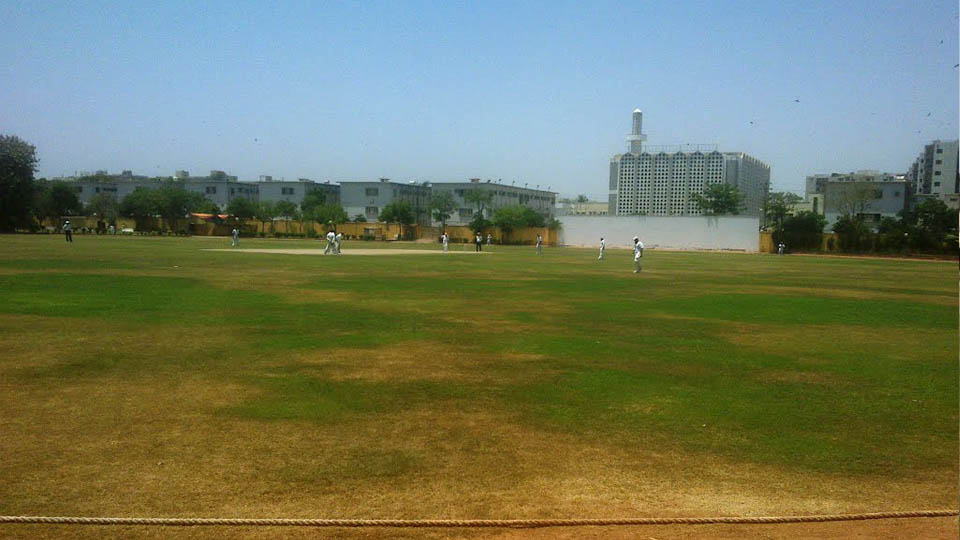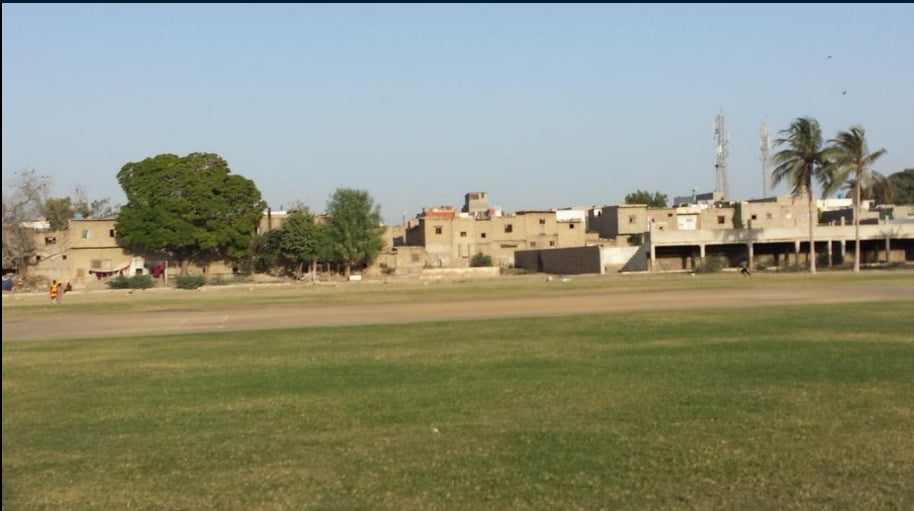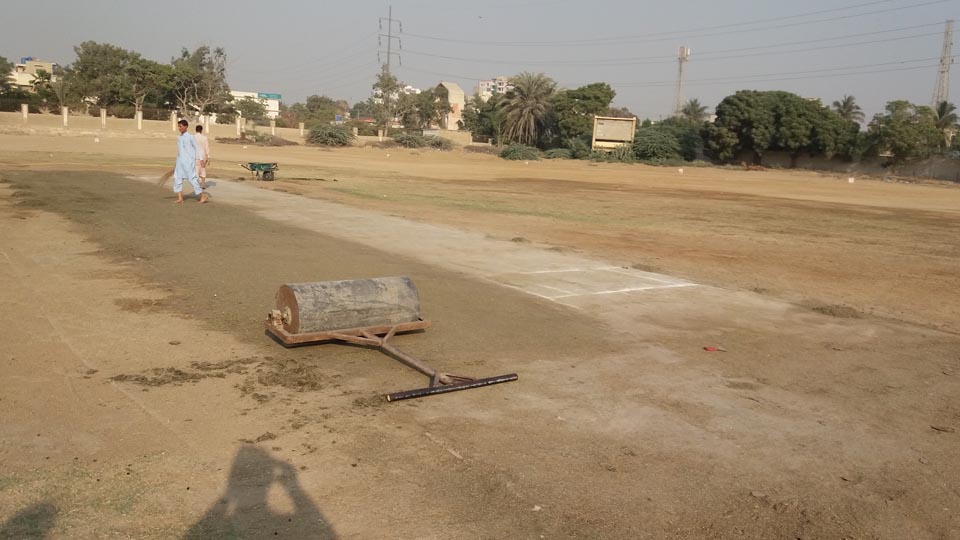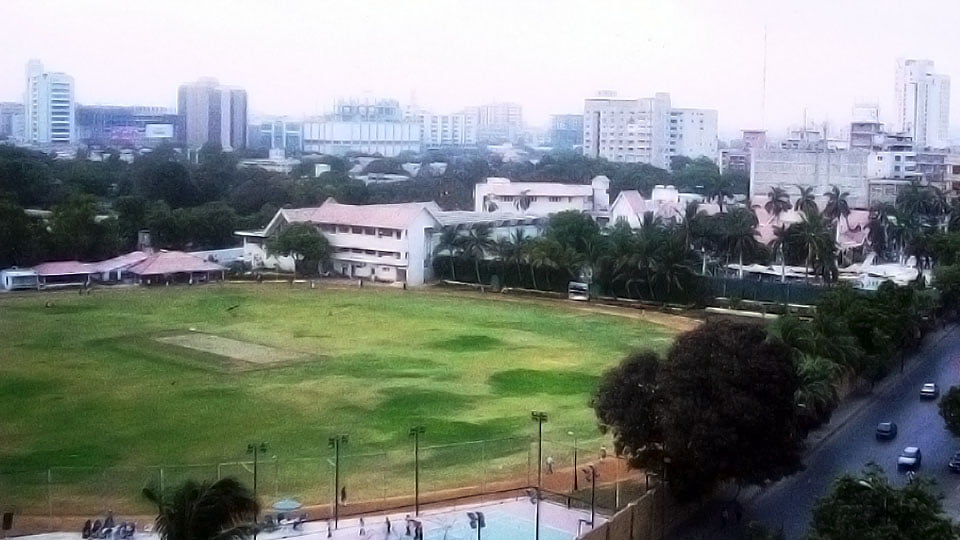Indeed it’s a tragedy that a number of historical cricket grounds of Karachi have become a thing of the past and the new generation may only get to read about them somewhere or learn from their seniors.
A number of cricket grounds, which used to be pride of the city in the early days after the creation of Pakistan in 1947, have withered and only their remains could be witnessed today.
Due to a combination of factors, they are now present only in the record books or could be found out in the archival records of cricket portals.
The metropolitan city of Karachi, having witnessed phenomenal population growth over the years, has clearly lagged behind in producing the desired facilities for sports and recreation for its inhabitants, now estimated to have crossed the magical figure of 20 million.

Aga Khan Gymkhana
Cricket remains the number one sport of the metropolis by a fair distance and the youth in particular has had incredible passion for it all along. No wonder cricket is enthusiastically played, despite the acute scarcity of playgrounds, in every nook and corner of Karachi be it on the streets or in the compound of the residential apartments.
The builders and developers, primarily due to commercial reasons, have not cared to allocate what’s understood to be mandatory space for playgrounds in their respective mega projects, which has forced the cricket-loving youngsters to play on roadsides and narrow lanes, which is indeed unfortunate.
The land grabbers with the collaboration of their cronies in the various departments have also played their role in depriving the people of their right to breathe fresh air. Many of the playgrounds or vacant pieces of land, earmarked for recreational purposes, have been converted into commercial plazas much to the annoyance of the area residents.
The downtown of Karachi also used to be the hub of cricket activities. Jahangir Park, Nishtar Park, Karachi Parsi Institute, Bohra Gymkhana, St Patrick School Ground, BVS Parsi School, Karachi Gymkhana, Aga Khan Gymkhana, KGA Gymkhana, Haji Abdullah Haroon Muslim Gymkhana, Hindu Gymkhana and Kakri Ground were among the busiest cricket grounds of the metropolis which generally remained occupied with players and spectators.
Only a few of them, like the cricket grounds of Karachi Gymkhana and Aga Khan Gymkhana, have survived the test of the times but the vast majority of them, including some of the historic ones, have bitten the dust.
Who would ever forget the Karachi Parsi Institute Ground, housed in Saddar. It had hosted its maiden first-class match in 1936-37 but it was immortalized a couple of decades later when Pakistan’s most prolific batsman of his generation, the great Hanif Mohammad, rewrote cricket history books.
Playing for Karachi against Bahawalpur, he scored a staggering 499 which was the highest individual score in an innings in first-class cricket. The record lasted for more than 35 years before being snatched by Brian Lara of the West Indies, who made an unbeaten 501 while playing for Warwickshire against Durham during an English County Championship game at Edgbaston.

Karachi Parsi Institute Ground
The Karachi Parsi Institute Ground had attracted worldwide attention due to Hanif Mohammad’s record-breaking innings which had ended rather tragically on that famous evening of January 11, 1959. Having batted for 635 minutes, the Little Master was run out on the final ball of the penultimate day while going for his 500th run in his team’s total of 772 for seven off 200 overs, Just for the record, Karachi went on to win the match by an innings and 479 runs the following day.
And it wasn’t his first big knock at the ground either. The legendary opening batsman had previously scored a double century against Sindh in 1954-55. He also scored a couple of more centuries at the Karachi Parsi Institute Ground which hosted its last first-class match in 1976-77.
Interestingly, the nearby Bohra Gymkhana Ground also hosted a first-class match, between Punjab Universities and Sindh University, in January 1959.
Put into bat, Punjab University amassed a massive score of 702 in only 123.2 overs. Remember there was no concept of limited-overs cricket those days and the scoring rate of nearly six run an over during the length of an entire innings was unheard of.
The centuries from skipper Saeed Ahmed, Khalid Aziz, Mohammad Yousuf and Zafar Altaf had helped maintain the astronomical run-rate. Sindh University, in reply, was bowled out for 199 in 80 overs. Following on, they scored 84 for six off 39 overs to save the match, however.
The BVS Parsi School Ground, housed also in Saddar, used to be yet another popular venue in the city. Although first-class matches were staged for only a couple of seasons, 1957-58 and 1958-59, it was in the headlines for hosting the prestigious Rubi Shield Inter-School Tournament, still talked about with awe.
Jahangir Park, Nishtar Park and Kakri Ground, it may come as a surprise to many readers, had also been among the most bustling cricket venues once upon a time in Karachi. The old timers will tell you how much club cricket was played at these three grounds until the 1960s.
One of the most important landmarks of the city, Jahangir Park, located in the heart of Saddar, faded over the years to turn into barren mud ground, rusting iron bars marking the boundary and a broken down fountain.
Historically the park, having served as a source of fresh air in the midst of an increasingly commercial district besides catering to the needs of the cricket lovers, was gifted to the people of Karachi by a Parsi philanthropist, Khan Bahadur Behramjee Jehangirjee Rajkotwala, in the year 1893. It also hosted several political rallies within its premises in the first decade after independence while it was the venue of its only first-class match in 1956.
Over the last few decades, however, the condition of the park steadily grew from bad to worse while apathetic officials tried to mint money out of the expanse of land, having tried to convert it into a parking facility while at other times using it as a commercial market for fruit vendors.
Jahangir Park and Nishtar Park were among the handful of cricket grounds in Karachi in the 1950s and the 1960s to have offered net practice facilities. Pakistan’s celebrated cricketers like Hanif Mohammad, Waqar Hasan and Alimuddin were seen in action quite often at these grounds at the peak of their career.
Nishtar Park, previously known as Patel Park, was named after Sardar Abdur Rab Nishtar, one of the top leaders of the Pakistan Movement. Located in Soldier Bazar, it was the home ground for the popular teams like Rangers Cricket Club and Jang Cricket Club.
As the city of Karachi expanded in all directions over the years with the influx of population, the cricket activities were also spread and the grounds in different parts of the metropolis gained popularity.
While National Stadium stole the limelight by becoming an international venue, having hosted Test matches since Pakistan’s first-ever home series in 1954-55, national and local tournaments used to be held at the places like Bakhtiari Youth Centre, KDA Sports Ground, Nazimabad Gymkhana Ground, Asifabad Sports Ground, Punjab Sports Ground, Shadab Cricket Ground, Sangam Cricket Ground and Eidgah Cricket Ground.
In the north of the metropolis, Bakhtiari Youth Centre, also known as National Youth Centre, hosted its maiden first-class match in 1971-72 with the last one having taken place in 1994-95. It had emerged as a regular venue for the national tournaments.

Bkhtairi Youth Centre
Khalid Alvi and Taslim Arif have been the only double centurions at this ground while the list of century-makers also includes eminent names like Nasim-ul-Ghani, Zaheer Abbas, Sadiq Mohammad, Saeed Anwar and Inzamam-ul-Haq. Test fast bowler Tahir Naqqash (9-45) and the great leg-spinner Abdul Qadir (9-82) had the most productive hauls in an innings at this venue.
The nearby KDA Sports Ground was also a busy centre for first-class matches from 1988-89 to 1996-97. There was a time not very long ago when the ground had a decent infrastructure for hosting national tournaments before receding into the background.
While Bakhtiari Youth Centre and KDA Sports Ground were located in North Nazimabad, the neighbouring Nazimabad also had a couple of fantastic venues in Nazimabad Gymkhana Ground, later named as Annu Bhai Park, and Eidgah Ground, which had played host to Karachi’s first-ever Ramazan Cricket Tournament by the name of Super Cup.
Asifabad Sports Ground in Pak Colony and Punjab Sports Ground in Drigh Colony, now Shah Faisal Colony, are among the oldest grounds of Karachi alongwith the Federal-B-Area twins of Shadab Cricket Ground and Sangam cricket Ground.
Among the older grounds to have survived and flourished over the years are Karachi Gymkhana and Aga Khan Gymkhana as both the clubs need to be credited for having met the challenge.
The history of Pakistan cricket will remain incomplete without the mention of Karachi Gymkhana, which had been hosting first-class matches a couple of decades before the independence.
It was at this particular venue in the winter of 1951 where Pakistan had overcome the visiting MCC by four wickets to earn the prestigious Test status. There were twists and turns during the course of the four-day match in which Pakistan’s fast bowlers Fazal Mahmood and Khan Mohammad had come up with sterling performance and they were backed by fine batting by opener Hanif Mohammad and skipper Abdul Hafeez Kardar.
Karachi Gymkhana, which hosted first-class matches from 1926-27 to 1986-87, has remained a popular venue all along and it was in the headlines during the ICC World Cup 1996 when England and South Africa had practiced at the ground for quite some time.
